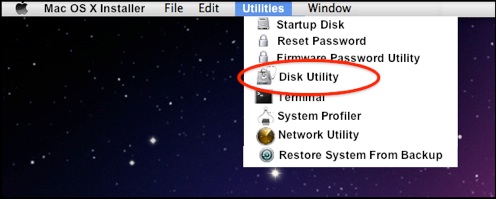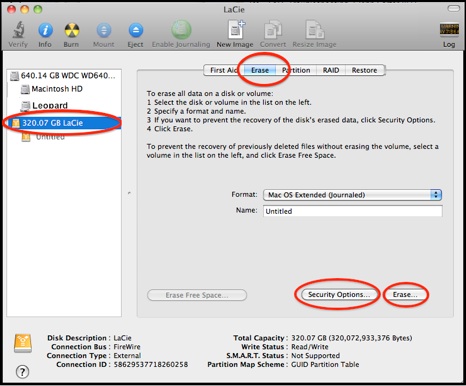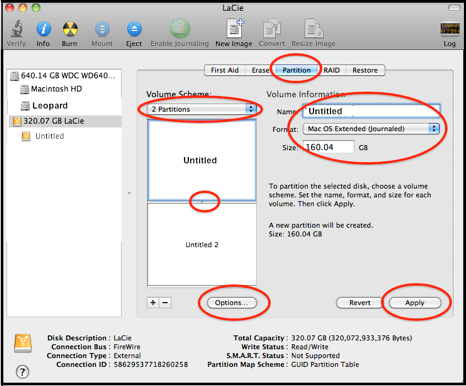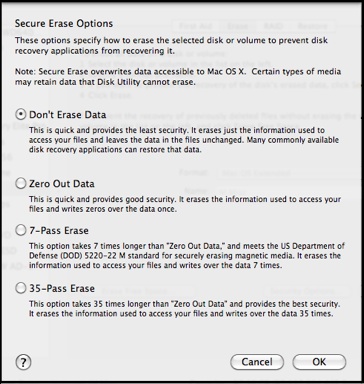OSX Tips: Using Disk Utility
1. Format, Erase, or Reformat a Drive
OSX Tips: Using Disk Utility
1. Format, Erase, or Reformat a Drive
This procedure will format or reformat an entire hard drive, erasing all the contents.
Note: to format a disk for use with Time Machine backups, see Time Machine FAQ #5.
To erase or reformat a single partition without disturbing any other partitions, see Erase or Reformat a partition.
You can use Disk Utility to format an entire internal or directly-connected external hard drive, but not the same drive you’re running from. To erase or format a drive connected to a network, you must connect it directly to your Mac via USB or Firewire.
Partitions to be used by Boot Camp must be added and managed by Boot Camp Assistant only. See Mac 101: Using Windows on your Mac via Boot Camp for details.
To format, erase, or reformat an internal or external HD that’s NOT the one you’re running OSX from, start the Disk Utility app in your Applications/Utilities folder. Then see the blue box below.
To format, erase, or reformat your Startup volume (the OSX volume on your internal HD), you must start your Mac up from a different source:
•On Lion or later, the Recovery HD or OSX USB thumb drive.
•On Snow Leopard or earlier, your OSX Install disc (or OSX USB thumb drive on a MacBookAir).
•Or, a different disk that has OSX installed on it. Be sure you use a compatible version of OSX -- if you’re running Leopard, use a Leopard disc; if you’re running Snow Leopard, use a Snow Leopard disc.
(If you're not sure what version of OSX you're running, see OSX Versions).
To start up from your OSX Install disc, insert it in the SuperDrive (or insert the Software Reinstall drive on a MacBook Air). Then:
•Either wait for the Mac OS X Install DVD window and double-click the Install icon; or power down, then start up while holding down the "C" key. Either way, that takes a few minutes.
•Select your language when prompted.

•On the next screen, select Utilities in the Menubar, then Disk Utility.
The sample below shows how to format an external HD (a LaCie, in this case). The same steps are used to format your Startup volume (internal HD) -- just select the one you want.
The sample shows making 2 partitions; the same steps work for 1, 3, or more.
a.When Disk Utility starts, select the top line for the drive in the sidebar (the line with the size and make/ID).

b.Select the Erase tab, then confirm. This will erase the entire disk.
If you want, you can select Security Options to physically erase the entire disk by writing over everything. This will take quite a while, and usually isn’t necessary, especially on a new disk, and can’t be done on an SSD. See the green box below for details.
This may not work if the drive is already set up with a non-Apple Partition Map Scheme, such as is used on Windows. If that happens, just continue with item c.

c.Select the Partition tab, then set the number of partitions from the pop-up menu below Volume Scheme (use 1 partition unless you need more).
Sometimes you can't change a MBR drive to GUID or APM and change the number of partitions at the same time; if that happens, make a single partition with GUID or APM first, then re-format with the desired number.
d.For each partition, click on it (it will then be outlined in blue), then supply a name (this is the name that will appear on your desktop and/or Finder sidebar) and size (either by typing in the box or dragging the dividers in the diagram), and select the desired Format from the pop-up. In most cases, you’ll want Mac OS Extended (Journaled). See Disk Formats for details.

f.When you've got everything the way you want it, click Apply. You’ll see a confirmation prompt, explaining exactly what’s about to happen. Read it carefully; if data is erased, it will be very difficult and expensive to get some of it back.
It will only take a few moments for
the process to complete.
If your disk doesn't appear at all, see If a disk doesn't appear in the sidebar.
If you get a message saying "Could not unmount disk," some other process is using (or trying to use) the disk:
•If you're running any anti-virus software, exclude the disk from it or turn it off.
•Exclude it from Spotlight indexing, via System Preferences > Spotlight > Privacy.
•If you installed any software that came with the disk, uninstall it.
If it still won't unmount, start your Mac up from an alternate source, per the yellow box above, and use that copy of Disk Utility.
Security Options can overwrite the disk with zeros, to prevent recovery of erased files.
The windows below are different, but the function is the same.
In most cases, a single pass is plenty.
Lion 10.7.x and later Snow Leopard 10.6.x and earlier

